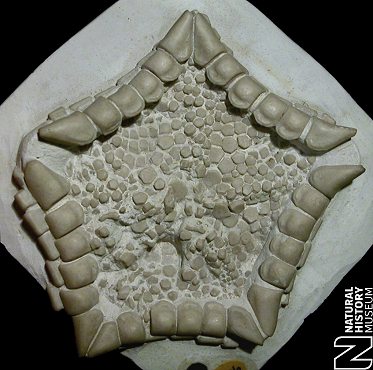 A A |
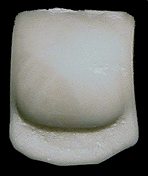 B B |
|
Metopaster uncatus (Forbes) |
A common form of Metopaster which occurs throughout the White Chalk. The marginal ossicles of this species are smooth, but with a pronounced groove running along the inner edge of the aboral marginal frame (superomarginals). Rugosites (small lumps) are also sometimes present on the superomarginals. Inferomarginals are typically smooth, usually with a recessed border.
 A A |
 B B |
1). (A) Aboral surface of a very well preserved individual, note the aligned groove running along the inner edge of the marginal frame (x1.5, Bromley, Kent, BMNH (British Museum (Natural History) London) 46776a; (B) Aboral view of a typical superomarginal ossicle, a sharply incised groove is present (x9, White Chalk, Randell Collection, RR1782). Image A © 2005 The Natural History Museum, by kind permission.
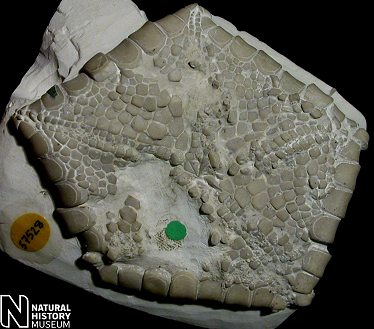 A A |
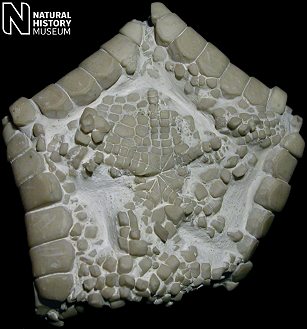 B B |
2). Oral views of two exceptionally preserved specimens, note that the inferomarginal ossicles are smooth except for the recessed border, and that the groove present on the superomarginals is absent; (A) x1.5, Bromley, Kent, BMNH (British Museum (Natural History) London) 57528; (B) x1.8, BMNH 46772. Images © 2005 The Natural History Museum, by kind permission.
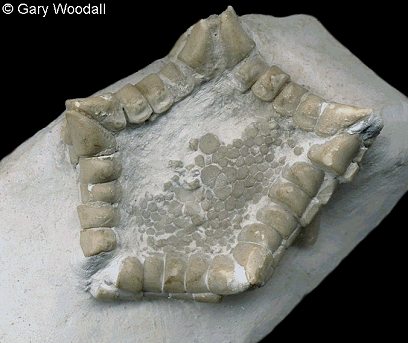 |
A |
 |
B |
3). Well articulated specimens viewed aborally; (A) a medium sized individual (x2, Cuxton, Kent, Lewes Chalk Formation (Sternotaxis plana zone), Gary Woodall Collection, GW197, by kind permission of Gary Woodall (MLMS)); (B) A moderatley large individual, exceptionally well articulated in places (x1.6, mould in flint, Swanmore, Hampshire, HCCMS (Hampshire County Council Museum's Service) collection, stored at Gosport Museum, G.1993.46, by kind permission of Dave Kemp, HCCMS).
 A A |
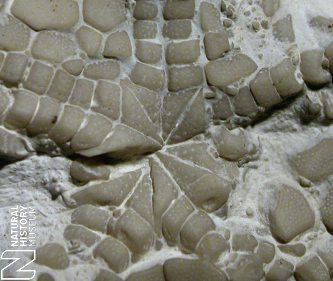 B
B |
4). (A) Aboral view of a large and very well preserved individual (x1.6, White Chalk, Willett collection, Booth Museum, BMB 007823, by kind permission of John Cooper); (B) Detail of the oral surface, retaining the mouth angle plates in near perfect articulation (x4.8, BMNH (British Museum (Natural History) London) 46772. Image B © 2005 The Natural History Museum, by kind permission.
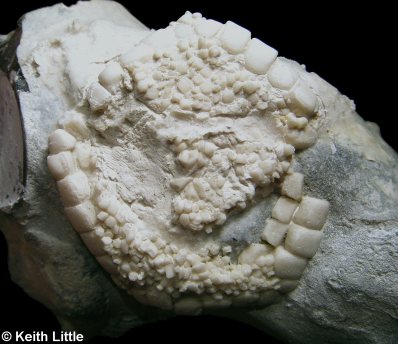 A A |
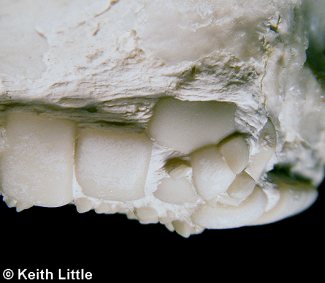 B B |
5). A well preserved specimen, partially encased in flint (Seaford Chalk, Thanet Coast, Kent, in the collection of Keith Little).; (A) General view of the oral surface (x1.8): (B) Lateral (side) view of arm tip - note the expanded ultimate superomarginal and the several corresponding inferomarginals (x5.0). Images © 2010 Keith Little, by kind permission.
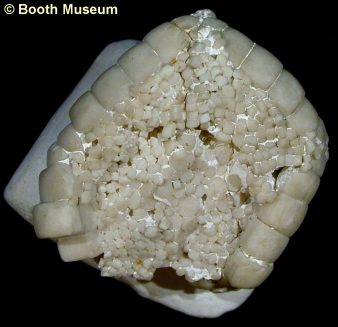 A A |
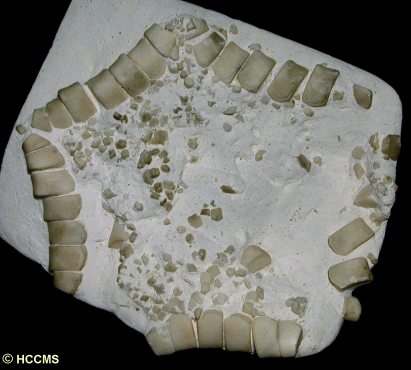 B B |
6). Oral surface; (A) Oral view of a beautifully preserved individual, note the smooth and featureless inferomarginal ossicles (x1.6, White Chalk, 'Brighton', Willett collection, Booth Museum, BMB 007828, by kind permission of John Cooper). (B) Oral view of a very large individual, the inferomarginals have a slight recessed border (x1.3, Alton area (Hampshire)?, White Chalk, HCCMS (Hampshire County Council Museum's Service) collection, stored at Gosport Museum, G.1983.426, by kind permission of Dave Kemp, HCCMS).
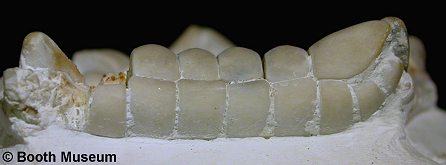 A
A |
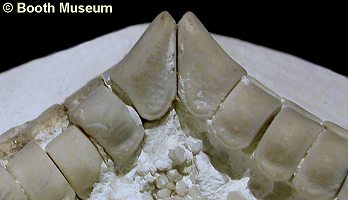 B
B |
7). Details of the marginal frame of a large individual (x3.2, Willett collection, Booth Museum, BMB 007823, by kind permission of John Cooper).; (A) Lateral (side) view; note the upturned arm-tips, the expanded ultimate superomarginal and the several corresponding inferomarginals; (B) Aboral view of the arm-tip.
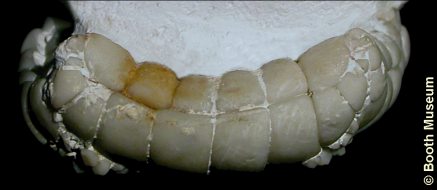 A
A |
 B B |
8). The marginal frame of a smaller individual, note that the ultimate superomarginal is relatively smaller, and with fewer corresponding inferomarginals (x2.2, White Chalk, 'Brighton', Willett collection, Booth Museum, BMB 007828, by kind permission of John Cooper); (A) Lateral view; (B) end-on view of the arm-tip.
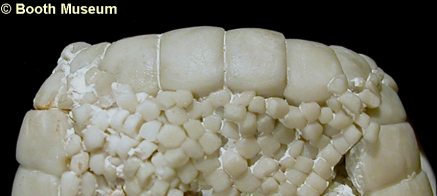 A A |
 B
B |
9). Details of the oral surface (inferomarginals); (A) This individual has virtually smooth inferomarginals (x2, White Chalk, 'Brighton', Willett collection, Booth Museum, BMB 007828, by kind permission of John Cooper); (B) These inferomarginals have a weakly developed recessed-border (x.3.6, Alton area (Hampshire)?, White Chalk, HCCMS (Hampshire County Council Museum's Service) collection, stored at Gosport Museum, G.1983.426, by kind permission of Dave Kemp, HCCMS).
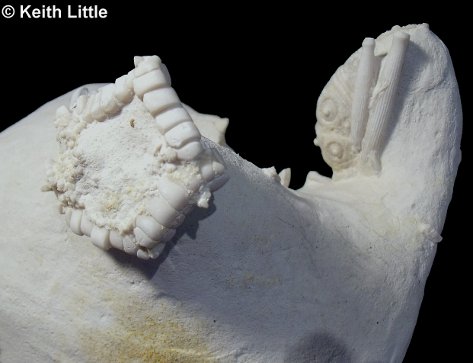 A A |
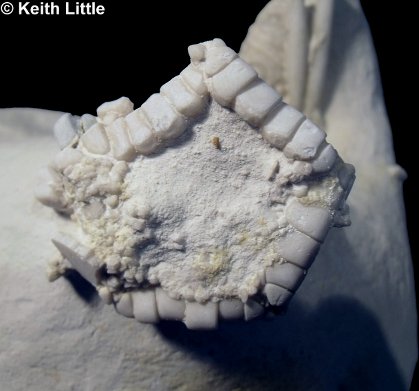 B B |
10). A well preserved individual associated with a partial example of Hirudocidaris hirudo: (A) Overview of the specimen (x1.8); (B) General view of the oral surface (2.5) (Seaford Chalk, Thanet Coast, Kent, in the collection of Keith Little). Images © 2011 Keith Little, by kind permission.
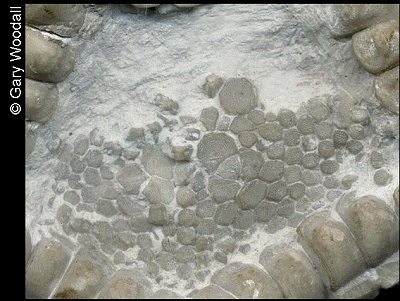 |
A |
 |
B |
11). Details of a well preserved aboral surface; (A) general view (x4); (B) Detail highlighting the madreporite (X6); (Cuxton, Kent, Lewes Chalk Formation (Sternotaxis plana zone), Gary Woodall Collection, GW197, by kind permission of Gary Woodall (MLMS));
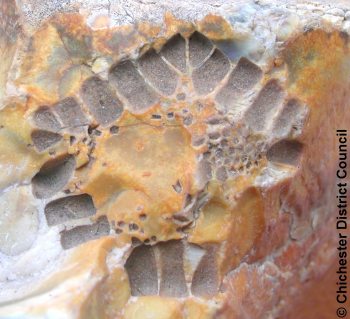 A A |
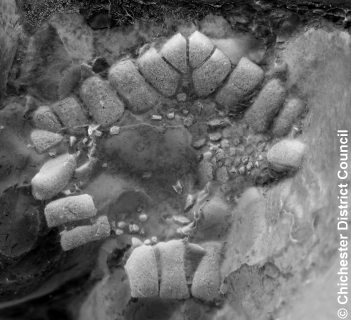 B
B |
12). Metopaster cf. uncatus?; this mould in flint has
virtually featureless inferomarginals, though a weakly developed recessed-border
is apparent in places. Though this is typical M. uncatus, it could
also be an artefact of preservational style (flint moulds often get coated by
secondary mineralogical processes); (A) natural-light view; (B) black and white
negative-view (x2, flint mould (from gravels, glacial drift?)
Southbourne, West of Chichester, south of the Downs, in the collections of
Chichester District Museum, © Chichester District Council).